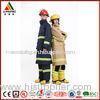

Hi Vis Reflective Safety Flame Resistant Firefighter Uniform for Men's and Women
| Place of Origin: | Zhejiang |
|---|
Company Profile
| Location: | Shenzhen, Guangdong, China (Mainland) |
|---|---|
| Business Type: | Manufacturer |
| Main Products: | Nomex Coveralls, Flame Retardant Coveralls, Fireman Turnout Gear |
Product Detail
| Model No.: | UX004 |
|---|
Product Description
Hi Vis Reflective Safety Flame Resistant Firefighter Uniform for Men's and Women
DESCRIPTION:Light weight three layer long coat
Flame-resistant, water proof with PTFE Moisture barrier
Comfort inherent flame resistant inner linning
FR drainage mesh into front pocket bottom
Knitted cuffs with thumb loop
FEATURES:
•Front closed by heavy duty FR zipper and FR Velcro .
•Two big patch pocket ,one radio pocket on left chest ,closed by Velcro.
•FR yellow silver yellow reflective tape in 3” width 3M Scotchlite
•High collar fully lined with throat closure tab
MATERIAL:PBI metric , 6.5 oz/m² / Nomex IIIA 6.0 oz/m²
SIZES:XS to 4XL
INTERNATIONAL STANDARDS:EN469 2005, GA10
COLORS:Navy blue ,orange ,yellow ,red ,Khaki

If you have design want to make, we can do as follows: Web:www.uprotec.com/web
1) You send us your design (samples or pictures or some ideas), so that we could know what you want exactly;
2) We make the samples for you then send you the pictures and samples by express;
3) As soon as you receive the samples and approve to us (if any changes we will follow them), then you can place the order to us;
Service we supply
1) The new design and new materials are provided as your requirements;
2) We are pleased to be given a test order;
3) The OEM services are available;
4) One-stop service: Satisfy what you want;

Care and Maintenance
PROPER WEARING
FR clothing can only provide protection if the wearer follows garment manufacturers' recommendations for proper use:
*Do not put on or take off the garment in proximity of flammable gasses, vapors, dusts or in other potentially explosive environments.
*In potentially explosive atmospheres, proper grounding procedures must be used.
*Wear garments with the appropriate arc rating as dictated by an electric arc hazard analysis. Consult employer if unsure.
*Wear garments properly – collars closed, sleeves and cuffs down and secured, shirt tails tucked, closures secured, and other manufacturer recommendations.
*Wear looser-fitting garments that provide adequate mobility.
*Do not wear non-FR clothing over FR garments. The outermost layer must be FR
*Wear only FR or non-melting undergarments (e.g. cotton, silk, wool.)
*Wash garments thoroughly after each wearing to remove contaminants.
CARE TIPS:
Most flame-resistant garments can be handled safely using common laundering and care procedures. However, a few precautions must be followed to ensure your FR garments maintain their maximum effectiveness. Remember: FR clothing is safety equipment that just might save your life. It is imperative to make sure your FR garments are properly cleaned and maintained.
Carefully follow the manufacturer's care label when laundering FR garments. Many FR fabrics require mild wash and dry conditions to maximize the life of the garment. *Wash new flame-resistant garments prior to wearing.
*Wash flame-resistant garments separately from standard clothing.
*Do not use chlorine bleach.
*Make sure FR garments are clean and in proper repair before each wearing.
*Remove oils and flammable contaminants from FR garments. Flammable contaminants can be a fuel source that adds to burn injury.
*Repair garments using "like materials." Use FR fabric, thread and components. Return garments to the manufacturer for repair, or use an authorized FR repair facility.
FAQ:
Is FR clothing uncomfortable?
FR clothing is a safety item for personnel working in environments with a hazard of clothing igniting. There are many climates where long pants and long sleeve shirts are hot, no matter what the fabric is made of. A variety of FR fabrics are available today, some of which are perceived as being more comfortable than others. FR clothing does not necessarily need to be more uncomfortable than standard clothing.
What do all these standards and test methods mean?

